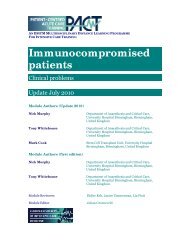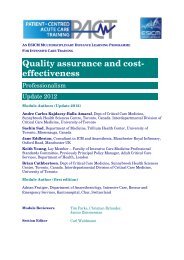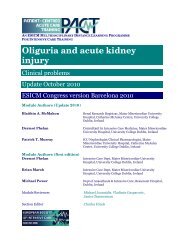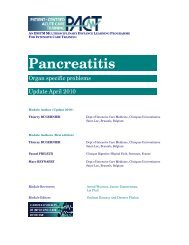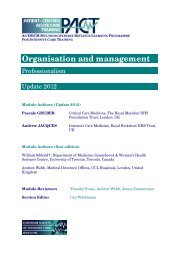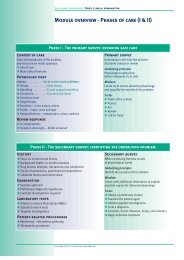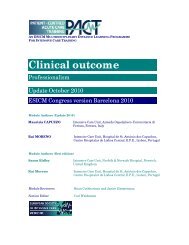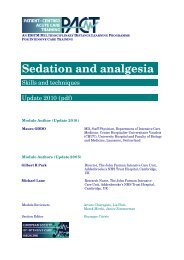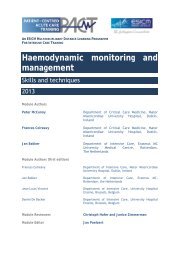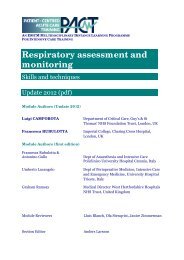Burns injury - PACT - ESICM
Burns injury - PACT - ESICM
Burns injury - PACT - ESICM
Create successful ePaper yourself
Turn your PDF publications into a flip-book with our unique Google optimized e-Paper software.
Sepsis diagnosis<br />
Catheter-related infection (CRI)<br />
See <strong>PACT</strong> modules on Sepsis and MODS, Severe infection and Pyrexia (for diagnosis of CRI).<br />
Specimen from a protected brush, (large volume of purulent sputum noted), urine, blood<br />
and swabs from burn sites have been sent to lab for microscopy, culture and sensitivity<br />
(MCS) analysis. Apart from an increasing leukocytosis, all other bloods including liver<br />
function tests are unremarkable. The first of three faecal samples for C. difficile toxin has<br />
been collected. All catheters have been changed. CXR shows a new left-sided<br />
consolidation; she now requires FiO 2 >80% to maintain saturation and she has become<br />
hypotensive despite increasing doses of vasopressor.<br />
Q. She has an evident respiratory infection. How will you treat it?<br />
A. Once the diagnosis of sepsis is made, immediate empirical antibiotic therapy is<br />
indicated pending laboratory results from the diagnostic specimens sent at the time of the<br />
septic work-up. Augmented supportive respiratory therapy will likely also be required.<br />
Q. Given that this is a nosocomial pneumonia, what will be your approach to antimicrobial<br />
therapy?<br />
A. Antibiotic therapy may be guided by urgent sputum microscopy or by recent microbial<br />
surveillance data, but should be broad and incorporate good Gram-negative cover. If<br />
resistant organisms such as MRSA are common in the unit, then antibiotics active against<br />
these organisms should be considered. Fungal infection is common in burn patients, usually<br />
several days post <strong>injury</strong>.<br />
Q. Although, a pulmonary infection is the apparent cause of this deterioration, what other<br />
infections may co-exist in this burn <strong>injury</strong> patient?<br />
A. In burn <strong>injury</strong> patients, always consider a wound infection and see that all necrotic<br />
tissue is excised. If there is clinical evidence or suspicion of C. difficile infection, oral<br />
metronidazole is indicated, pending toxin results.<br />
<strong>PACT</strong> module Sepsis and MODS<br />
<strong>PACT</strong> module Severe infection<br />
She was commenced on piperacillin/tazobactam together with fluconazole and oral<br />
metronidazole and rapidly improved in the following 48 hours. Cultures from the protected<br />
brush specimen showed a heavy growth of sensitive Pseudomonas sp. as did her burn site<br />
55




